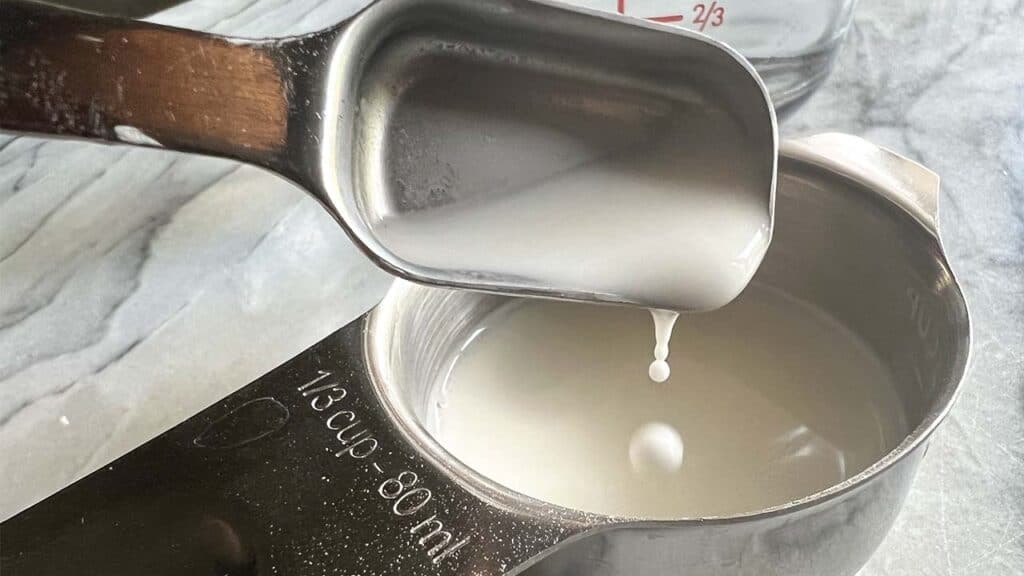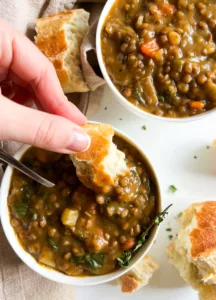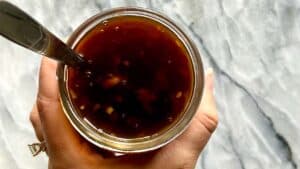Cornstarch Slurry: A Thickening Solution
This Cornstarch Slurry Recipe is a versatile staple in any vegan kitchen, ideal for thickening sauces, soups, stews, and more. Commonly used in Asian cuisine, cornstarch slurry is prized for achieving the perfect consistency in a variety of dishes.
The Basics of Cornstarch Slurry
Cornstarch requires heat to activate its thickening properties, making it essential to add the slurry to already heated dishes or sauces. It’s a quick and easy recipe that can be made in under 5 minutes. Providing a gluten-free, dairy-free, and vegan alternative to traditional flour-based thickeners. This makes it perfect for those seeking a healthy and versatile thickening agent.
Ingredients & Substitutions: What Is in Cornstarch Slurry
To make a vegan cornstarch slurry, you need only two ingredients: cornstarch and water. The standard ratio is one part cornstarch to one part cold water. For example, if you use 2 tablespoons of cornstarch, you’ll need 2 tablespoons of cold water. This means you’ll use one part starch to one part water. Using cold wateris the best way to ensure the cornstarch dissolves completely without forming lumps. However, room temperature water can be used if needed.
Some chefs like to use chicken stock instead of water for added flavor in non-vegan dishes. However, this substitution would not be suitable for vegans. For vegan recipes, sticking with water or vegetable broth is recommended to maintain the dish’s vegan integrity.
Substitutions and Variations
While cornstarch and water form the basic slurry, there are other ingredients and techniques you might consider:
- Vegetable Broth: For a richer flavor without compromising on vegan principles, use vegetable broth instead of water.
- Arrowroot Powder or Tapioca Starch: These can be used as alternatives to cornstarch, providing a slightly different texture and appearance to the final dish.
- Milk-Based Sauce: Cornstarch slurry works well in vegan milk-based sauces, offering a smooth and creamy texture.
Tips for the Perfect Cornstarch Slurry
- Cold Liquid: Always mix cornstarch with cold liquid to prevent clumping. Adding cornstarch directly to hot liquids can result in small bits of undissolved starch.
- Gradual Addition: Add the slurry gradually to your simmering liquid while stirring continuously to achieve the desired consistency.
- Whisk Thoroughly: Using a wire whisk to combine the cornstarch and water helps create a smooth mixture.
- Quick Mixing: Make the slurry right before you need to use it to ensure it stays smooth and doesn’t separate.
- Adjust as Needed: Start with a small amount of slurry and add more if necessary to reach your desired thickness.
Common Questions and Answers
For more tips and troubleshooting, consider exploring q&a communities like Stack Overflow, where chefs and home cooks discuss the thickening powers of cornstarch compared to other agents like flour. The main difference between these thickeners is that cornstarch provides a glossy finish and thickens quickly, while flour needs more time to cook and often requires a mixture of flour and fat (roux) to avoid a raw taste.
Step-by-Step Guide
- Measure Ingredients: For every tablespoon of cornstarch, use an equal amount of cold water.
- Mix Thoroughly: In a small bowl, combine the cornstarch and cold water using a wire whisk to ensure a lump-free mixture.
- Add to Dish: Gradually stir the slurry into your simmering liquid, whether it’s a sauce, soup, or stew.
- Cook Briefly: Continue cooking for a couple of minutes until the desired consistency is reached. If the mixture becomes too thick, add a little extra liquid to thin it out.
Using Cornstarch Slurry in Recipes
Cornstarch slurry is versatile and can be used in various dishes:
- Pan Sauces and Gravies: Ideal for thickening pan sauces made from meat drippings or vegetable sauté.
- Milk-Based Sauces: Perfect for vegan cream sauces, giving them a smooth texture without dairy.
- Sweet Sauces: Useful in desserts to thicken fruit fillings and sweet sauces.
- Hot Sauce and Savory Dishes: Incorporate the slurry into hot sauce recipes for a thicker consistency.
Understanding how to properly make and use cornstarch slurry can elevate your cooking, whether you’re creating a savory meat dish, a sweet dessert, or a simple sauce. By following these basic steps and considering the main difference between cornstarch and other thickeners, you’ll achieve the desired consistency every time. For more detailed guidance, recipes, and tips, online communities like Stack Exchange Network offer valuable insights from fellow home cooks and professional chefs.
Cornstarch vs Flour: Understanding the Differences
When it comes to thickening agents, cornstarch and flour are the two most commonly used ingredients, but they have distinct properties and uses. Cornstarch has about twice the thickening power of flour, meaning you need less cornstarch to achieve the same thickening effect. This makes cornstarch a more efficient option for creating smooth, glossy sauces without altering the flavor.
Flour slurry, on the other hand, needs to be cooked longer to eliminate its raw taste and can sometimes impart a cloudy appearance to the dish. Additionally, cornstarch thickens at a higher temperature and works best when added to hot liquids, whereas flour can be used to make a roux, cooked at the start of a recipe with fat before liquids are added. Understanding these differences helps in choosing the right thickener for your recipe, ensuring the desired texture and consistency.
Cornstarch vs Flour
| Feature | Cornstarch | Flour |
|---|---|---|
| Thickening Power | Twice as powerful as flour | Less powerful; needs more quantity |
| Appearance | Smooth and glossy | Can be cloudy |
| Cooking Time | Thickens quickly | Requires longer cooking to remove raw taste |
| Usage | Best added to hot liquids | Often used in roux, cooked with fat |
| Temperature for Thickening | Higher temperatures | Can be used from the start of cooking |
| Gluten Content | Gluten-free | Contains gluten |
Gluten Content: Cornstarch vs Flour
One significant difference between cornstarch and flour is their gluten content. Cornstarch is naturally gluten-free, making it an excellent choice for those with gluten sensitivities or celiac disease. It can be used to thicken sauces and soups without adding any gluten. In contrast, flour, especially all-purpose flour, contains gluten, which can be problematic for those with gluten intolerances. Therefore, for gluten-free cooking and baking, cornstarch or other gluten-free thickeners like arrowroot powder or tapioca starch are better options.
Is Corn Flour the Same as Cornstarch?
Corn flour and cornstarch are often confused, but they are not the same and serve different purposes in cooking and baking.
Cornstarch is a fine, white powder made from the starchy part of the corn kernel. It’s commonly used as a thickening agent in soups, sauces, gravies, and pie fillings. Cornstarch is known for its ability to create a smooth and glossy texture in liquids, and it thickens quickly when added to hot liquids. It is gluten-free, making it suitable for those with gluten intolerances.
Corn Flour, on the other hand, is made by grinding the entire corn kernel into a fine yellow powder. It contains protein, fiber, starch, and other components of the corn kernel. Corn flour is used differently than cornstarch and is more similar to other flours like wheat flour. It’s commonly used in baking to make cornbread, tortillas, and certain types of pastries. Unlike cornstarch, corn flour does not have the same thickening properties and cannot be used as a direct substitute for cornstarch in recipes requiring a thickener.
In summary, while both corn flour and cornstarch are derived from corn, their uses in the kitchen are quite distinct. Cornstarch is a powerful thickening agent used in liquids, while corn flour is a versatile baking ingredient that adds texture and flavor to baked goods. Understanding the differences between these two ingredients ensures that you choose the right one for your cooking and baking needs.
Helpful Tools
While making a cornstarch slurry doesn’t require any special equipment, the following tools can simplify the process:
- Whisk or Fork: A whisk or fork helps mix the cornstarch and water thoroughly, ensuring no lumps in the slurry.
- Measuring Cups and Spoons: These tools help accurately measure the cornstarch and water, maintaining the correct ratio.
- Small Bowl or Measuring Cup: These are used to mix the cornstarch and water, making it easier to pour the slurry into your recipe.
How to Make This Cornstarch Slurry
- Measure Ingredients: Start by measuring the desired amount of corn starch and cold water using a 1:1 ratio. For instance, if you need 1 tablespoon of cornstarch, use 1 tablespoon of cold water.
- Mix Thoroughly: Combine the cornstarch and water in a small bowl or measuring cup, whisking or stirring with a fork until the mixture is smooth and lump-free. It’s best to mix the slurry right before adding it to your recipe to ensure it remains smooth.
- Add to Hot Liquid: Pour the slurry into your hot liquid, such as a simmering sauce, gravy, stew, or soup, while stirring continuously. This helps to evenly distribute the slurry and prevent clumping.
- Cook and Adjust: Allow the dish to cook for a few minutes to activate the thickening properties of the cornstarch. Adjust the thickness by adding more slurry if needed or thinning with extra liquid if it becomes too thick.

Tips & Tricks for Perfect Cornstarch Slurry
- Use Cold Water: Mixing cornstarch with cold water helps prevent clumping and ensures the cornstarch dissolves fully.
- Immediate Mixing: Mix the slurry just before adding it to your dish to maintain a smooth texture.
- Gradual Addition: Add the slurry gradually to your recipe, stirring constantly to achieve the desired thickness without creating lumps.
- Adjust for Preference: Adjust the amount of slurry based on your personal preference for the dish’s thickness.
Optional Ingredients and Variations For This Cornstarch Slurry Recipe
- Dry White Wine: Adding a splash of dry white wine can enhance the flavor of savory sauces and gravies.
- Tapioca Starch or Potato Starch: These can be used as alternatives to cornstarch, offering different textures and properties.
- Arrowroot Powder: Another excellent alternative, providing a glossy sheen to sauces and soups.
Applications in Various Dishes
Cornstarch slurry is a common thickening agent in many recipes:
- Soups and Stews: Perfect for thickening hearty soups and stews, like beef stew, without altering the flavor.
- Sauces and Gravies: Ideal for creating a flavorful sauce or quick gravy sauce.
- Pie Fillings and Sweet Sauces: Works wonderfully in fruit pie fillings and sweet dessert sauces.
- Asian Cuisine: Essential in Asian recipes for achieving the right consistency in dishes like stir-fries and soups.
- Milk-Based Sauces: Can be used in vegan versions of milk-based sauces for a smooth texture.
The Science Behind Cornstarch Slurry
Cornstarch thickens by a process called starch gelatinization. When the starch granules are heated in the presence of liquid, they absorb water and swell, thickening the liquid. This is why it’s crucial to add the slurry to hot liquids for it to work effectively.
FAQ: Vegan Cornstarch Slurry Recipe
Adding cornstarch directly to your hot soup or sauce without creating a slurry first can lead to unsavory clumps. To prevent this, a slurry is made by mixing cornstarch with a small amount of cold liquid. Such as water or broth, before adding it to your dish. This ensures a smooth, lump-free texture for your final product. It’s pretty gross to hit the texture of a cornstarch clump in your dish. 😂
Cornstarch has twice the thickening superpowers that flour has. So sub in 1 tbsp of cornstarch for every 2 tbsps of flour. Only half the cornstarch is needed to provide the same thickening result.
No, it’s best to use cold water to prevent clumping and ensure that the cornstarch dissolves fully.
No, corn flour and cornstarch are not interchangeable. Cornstarch is a finer and more processed version of corn flour, which makes it better for thickening.
It’s not recommended to use a blender or food processor to mix the slurry as it can create too much air and cause the slurry to become frothy. A whisk or fork is the best tool for mixing the slurry.

Cornstarch Slurry
Ingredients
- 1 part cornstarch
- 1 part cold water
Instructions
- Mix the cornstarch and water together thoroughly right before adding into a sauce, gravy, stew, soup or anything else you'd like to thicken.
- If you are using 1 tbsp of cornstarch use 1 tbsp of cold water.
Video
Notes
Nutrition
Conclusion: Cornstarch Slurry Recipe
Get smooth and lump-free vegan dishes with this cornstarch slurry recipe. By mixing cornstarch with cold water before adding it to your dish, you’ll ensure a smooth and lump-free consistency every time. This simple mixture of cornstarch and water is a secret weapon in the kitchen, perfect for thickening a wide range of recipes. Say goodbye to clumpy sauces and enjoy the perfect texture in your soups, gravies, and more.
With these tips and information, you’ll be able to confidently use cornstarch slurry to enhance the texture of your culinary creations. Enjoy the versatility and ease of this common thickening agent in your cooking endeavors.
Additional Information on Cornstarch Slurry
Cornstarch slurry is a common thickening agent used in various culinary arts. Its main advantage over flour-based thickeners is that it doesn’t impart any taste to the dish, making it perfect for delicate sauces and soups. When mixed with cold liquid and added to a simmering sauce, cornstarch molecules swell and create a thick, smooth texture.
One big difference between cornstarch and flour is the thickening power. Cornstarch has about twice the thickening power of flour, so you need less cornstarch to achieve the same effect. This makes it a more efficient thickener and ideal for those who want to minimize the addition of extra ingredients.
When using cornstarch slurry, it’s important to note that overcooking can cause the mixture to break down, leading to a spongy texture. Therefore, it’s best to add the slurry towards the end of the cooking process.
Using Cornstarch Slurry in Different Recipes
- Pan Sauces: Enhance the consistency of your pan sauces by adding a cornstarch slurry. Simply deglaze the pan with some broth or wine, then add the slurry to thicken.
- Gravy: For a quick gravy sauce, mix the slurry into your meat drippings or vegetable broth and simmer until thickened.
- Fruit Pie Fillings: Achieve the perfect thickness for your fruit pie fillings by incorporating a cornstarch slurry, preventing a runny pie.
- Milk-Based Sauces: Use cornstarch slurry to thicken vegan milk-based sauces without altering their flavor.
Keywords and Concepts
- Hot Liquids: Cornstarch slurry should be added to hot liquids to activate its thickening properties.
- Cup of Liquid: Adjust the amount of slurry based on the cup of liquid you need to thicken.
- Starch Gelatinization: The process through which starch thickens a liquid when heated.
- Parts Liquid: Ensure the correct ratio of parts liquid to cornstarch for the best results.
- Spongy Texture: Overcooking cornstarch can lead to an undesirable spongy texture.
- Starch Granules: Heat causes starch granules to swell and thicken the liquid.
- Cornstarch Molecules: These molecules absorb water and expand when heated, thickening the mixture.
- Mixture of Equal Parts Cornstarch: Always use a mixture of equal parts cornstarch and cold water.
- Stack Exchange Network: An online community where you can find more tips and Q&A about using cornstarch slurry.
- Thickening Power of Flour: Cornstarch has more thickening power compared to flour.
- Pan Drippings: Use pan drippings as a base for a gravy thickened with cornstarch slurry.
- Sizzling Liquid: Ensure your liquid is simmering when adding the slurry for optimal thickening.
- Glossy Sheen: Cornstarch slurry gives a glossy sheen to sauces, enhancing their appearance.
By understanding these concepts and tips, you can master the use of cornstarch slurry in your cooking, achieving the perfect consistency and texture for your dishes.





Great. Thank you for all the detail in your instructions. 😁
You’re welcome! Thank you so much for trying it out! I try to make all my vegan recipes super easy to follow 🥰
Great! Quick easy and simple to make thank you!
Hi Martha, thank you so much for trying out my recipe, so happy it was easy to follow. 😊